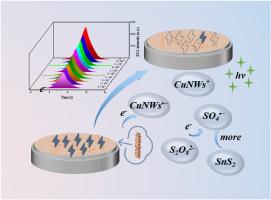Low-potential bionic electrochemiluminescence sensing platform based on SnS2/CuNWs synergistic promotion for highly selective detection of glycocholic acid
IF 5.7
2区 化学
Q1 CHEMISTRY, ANALYTICAL
引用次数: 0
Abstract
Background
Glycholic acid (GCA) can dynamically reflect the process of liver injury, and can be used for early diagnosis and curative effect evaluation of early hepatitis and cirrhosis. The highly sensitive detection of liver injury markers is conducive to a more accurate and effective auxiliary diagnosis of liver diseases. In addition, the low trigger potential helps to avoid more chemical interference and improve the detection sensitivity. It is of great significance to develop a high sensitive and low potential ECL sensor for GCA detection.
Results
In this work, a low trigger potential molecularly imprinted electrochemiluminescence sensor (MIECLS) combining SnS2 and CuNWs was proposed for highly selective and sensitive detection of GCA, a marker of liver injury. The stabilization and enhancement of ECL signal can be attributed to the synergistic promotion strategy of SnS2 and CuNWs. CuNWs not only has good ECL performance, but also serves as a substrate material for loading SnS2 to enhance the film forming performance. In addition, the Sn4+ active site can be regenerated by redox reaction, significantly improving the efficiency of the co-reactant and the stability of the sensor. By studying the ECL luminescence mechanism and specific recognition quenching mechanism of MIECLS in detail, a selective detection method for GCA was established. Under optimal conditions, in the range of 5 × 10−10 to 5 × 10−6 mol L−1, the quenching value of ECL intensity is proportional to LgCGCA, and the limit of detection is 1.30 × 10−10 mol L−1.
Significance and novelty
In addition, satisfactory recovery rate was obtained in human serum samples, showing good practical application, providing a new way for clinical detection of GCA. At the same time, it not only broadens the development of CuNWs in the ECL field, but also provides a new way to reduce the triggering potential.


基于SnS2/CuNWs协同促进的低电位仿生电化学发光传感平台用于高选择性检测糖胆酸
背景甘胆酸(GCA)能动态反映肝损伤过程,可用于早期肝炎、肝硬化的早期诊断和疗效评价。肝损伤标志物的高灵敏度检测有助于更准确、有效地辅助诊断肝脏疾病。此外,低触发电位有助于避免更多的化学干扰,提高检测灵敏度。研制高灵敏度、低电位的ECL传感器对GCA检测具有重要意义。结果本研究提出了一种结合SnS2和CuNWs的低触发电位分子印迹电化学发光传感器(MIECLS),用于肝损伤标志物GCA的高选择性和高灵敏度检测。ECL信号的稳定和增强可归因于SnS2和CuNWs的协同促进策略。CuNWs不仅具有良好的ECL性能,还可以作为加载SnS2的衬底材料来增强成膜性能。此外,Sn4+活性位点可以通过氧化还原反应再生,显著提高了共反应物的效率和传感器的稳定性。通过对ECL发光机理和MIECLS特异性识别猝灭机理的详细研究,建立了GCA的选择性检测方法。在最佳条件下,在5 × 10−10 ~ 5 × 10−6 mol L−1范围内,ECL强度的猝灭值与LgCGCA成正比,检出限为1.30 × 10−10 mol L−1。此外,在人血清样品中获得了满意的回收率,具有良好的实际应用价值,为临床检测GCA提供了新的途径。同时,它不仅拓宽了cunw在ECL领域的发展,而且为降低触发电位提供了新的途径。
本文章由计算机程序翻译,如有差异,请以英文原文为准。
求助全文
约1分钟内获得全文
求助全文
来源期刊

Analytica Chimica Acta
化学-分析化学
CiteScore
10.40
自引率
6.50%
发文量
1081
审稿时长
38 days
期刊介绍:
Analytica Chimica Acta has an open access mirror journal Analytica Chimica Acta: X, sharing the same aims and scope, editorial team, submission system and rigorous peer review.
Analytica Chimica Acta provides a forum for the rapid publication of original research, and critical, comprehensive reviews dealing with all aspects of fundamental and applied modern analytical chemistry. The journal welcomes the submission of research papers which report studies concerning the development of new and significant analytical methodologies. In determining the suitability of submitted articles for publication, particular scrutiny will be placed on the degree of novelty and impact of the research and the extent to which it adds to the existing body of knowledge in analytical chemistry.
 求助内容:
求助内容: 应助结果提醒方式:
应助结果提醒方式:


